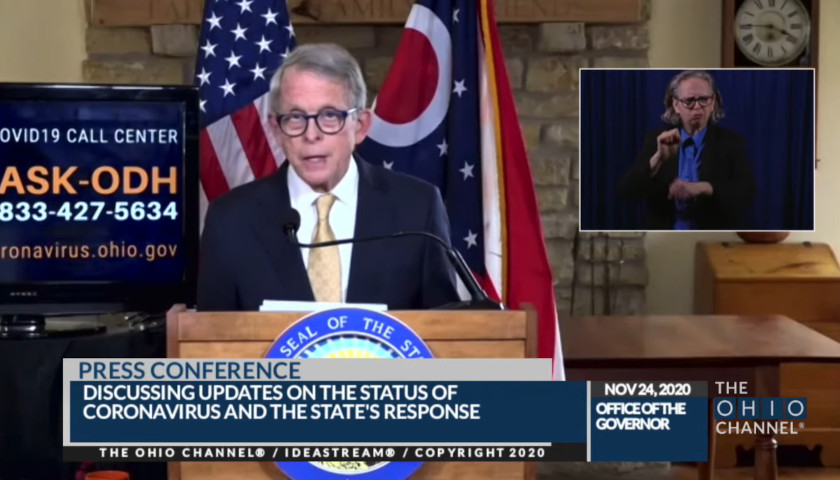The Ohio Star reported that Ohio Governor Mike DeWine called a special press conference on Monday alongside the Ohio Hospital Association leaders to address the state’s COVID hospitalization rise.
As reported, during the briefing doctors who lead each of Ohio’s three zones (the state is segmented into three areas) disclosed staffing shortages due to COVID quarantine orders, which had further depleted caregiving capacity already run thin by upticks in COVID hospital cases around the state.
The Star has received inquiries from readers describing their situations. One woman told the story of her husband who was alerted that he had been exposed to COVID and within days began exhibiting symptoms. When he called his doctor seeking preventative therapies, he was denied. The man was later admitted to a hospital for days, where he received therapeutic treatments that aided his recovery.
Consequently, The Star took the opportunity during DeWine’s twice-weekly COVID presser on Tuesday to ask the following question:
Two-part question: how does the level of hospital capacity right now compare to 2018 and 2019? We’re hearing that patients who want therapies cannot get them with outpatient visits, or outpatient ER visits, but they’re having to be admitted in order to get Remdesivir, HCQ and other things that they could take orally. Is it possible to get therapies to people more proactively? And would that help take some of the pressure off hospitals and would it help lower the number of people who are getting seriously ill from the virus?
DeWine said:
I’ll let Bruce (Ohio Chief Medical Advisor Bruce Vanderhoff) do that but as far as hospital capacity, what we quoted you today was of course COVID in the hospital. Of course, we didn’t have COVID in the hospital in 2018 and 2019. As far as total capacity. Are you talking about the capacity? Or are you talking about how many people are in there?
The Star clarified –
Yeah, thank you for clarifying, governor. I get a lot of messages and many people are saying that at this time of year, hospitals are traditionally extremely full. And so, we don’t have, necessarily, visibility into that. So, I’m just asking based on previous years how we’re looking with overall capacity.
DeWine and Dr. Vanderhoff responded:
DeWine: Well, let’s ask a man who has been working in hospitals for a long, long time.
Vanderhoff: First, in terms of hospital capacity – our hospitals are extremely busy. I think you undoubtedly heard that yesterday from the three zone leads. I can tell you as someone who has been responsible for helping guide one health system through this response that’s very, very real.
Any time that you have a single diagnosis that is occupying 20%-30% of the beds in your hospitals, you’re extremely busy because that’s unheard of, to have a single diagnosis using up that much of your capacity. So that’s the capacity question.
The question that you are asking about access to medications in the ambulatory arena is a really, really good one, but what we have to understand is that most of the medications that have been available, that we’ve had – emergency use authorizations, or have been otherwise released for us to use, have in fact been targeted to the very sick patients who are in the hospital.
And the research has demonstrated their effectiveness in that environment. It’s only been very recently that we’ve had medications that have come to us that are really targeted to the outpatient environment. And the best example are these new monoclonal antibodies.
We, in Ohio, received those medications just toward the end of last week. And in many instances, within 12 hours of receiving them, our health systems around the state were already putting them into – because these are infusions – putting them into patients.
So, it’s a good question. But, I think we are responding very rapidly to getting what can be given in the outpatient arena there – we’re waiting for more to come.
Ohio has 27,288 inpatient beds, 4,798 ICU beds, and 5,280 ventilators, according to numbers released on the state hospital dashboard.
As of Tuesday, the number and percentage use of each was as follows:
- Inpatient beds – 4,449 used by COVID patients, approximately 16% of capacity;
- ICU beds – 1,046 used by COVID patients, approximately 22% of capacity;
- Ventilators – 598 used by COVID patients, approximately 11% of capacity.
As of Wednesday, there Ohio hospitals have reported 25,069 COVID patients year-to-date, according to the state COVID hospital metrics page.
The U.S. Food and Drug Administration (FDA) currently lists Emergency Use Authorization for therapies convalescent plasma, REGIOCIT, Remdesivir, Fresenius Propoven and MultiFiltrate PRO System. On the list, therapies to treat COVID – Remdesivir and plasma – must be administered with infusion/intravenously, according to the administration.
Remdesivir, early studies showed, was most effective when administered both intravenously and by inhalation.
Five days ago, the FDA granted emergency use of another intravenous treatment. According to the FDA release:
In a clinical trial of patients with COVID-19, casirivimab and imdevimab, administered together, were shown to reduce COVID-19-related hospitalization or emergency room visits in patients at high risk for disease progression within 28 days after treatment when compared to placebo.
Arguably the most controversial of prospective COVID treatments, HCQ was a drug Governor DeWine chose to stockpile. According to Statehouse News Bureau, Ohio purchased two million doses at a cost of $602,629.
Then in June the FDA revoked the Emergency Use Authorization of Hydroxychloroquine (HCQ) and chloroquine.
On July 20, the State of Ohio Board of Pharmacy outlawed the dispensation of HCQ, but only 10 days later reversed the rule.
The order reversal and stockpile become headline topics now as controversial doctor Vladimir Zelenko releases a peer-reviewed study in the December issue of Internal Journal of Antimicrobial Agents.
According to the report, the study is the first COVID outpatient research based on risk stratification and early antiviral treatment at the beginning of the disease. Low-dose hydroxychloroquine, zinc and azithromycin were administered to 141 COVID patients, according to Dr. Zelenko. The study found “the odds of hospitalization of treated patients was 84% less than in untreated patients.”
WMFD reported in May on a 71-year old female health worker who contracted COVID despite masking and following distancing and sanitizing protocol. In the report it was noted that she received – at her request – early dispensation of HCQ, zinc, high levels of vitamin C and an anticoagulant. It was also written that she began felling better almost instantly. According to the interview, the woman and her 73-year old husband, who also contracted the contagion, both recovered.
It is not clear whether there are other treatments available that remain unlisted by the FDA sheet or if there those coming down the pipeline that would be able to be administered orally, or without hospital admission. It is also not clear whether Ohio medical providers can provide the HCQ drug cocktail or other therapies on an outpatient basis.
If not, Governor DeWine may consider exercising the pressure he did back in March when he contacted President Trump and insisted the FDA approve Columbus-based Battelle’s N-95 mask decontamination technology. The request spawned FDA authorization.
The Governor’s full address can be viewed below.
– – –
Jack Windsor is Managing Editor and an Investigative Reporter at The Ohio Star. Windsor is also an Investigative Reporter at WMFD-TV. Follow Jack on Twitter. Email tips to [email protected].





